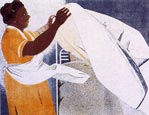Lithographic Print

Drawn plate
being inked,
printed & print
being removed.
Lithography is based on the simple principle that grease and water do not mix.
A design is drawn or painted directly on to the prepared surface. Originally large lime stone blocks were used, today zinc and aluminium sheets are more commonly used.
A wide range of grease based materials, such as crayons, paints, inks etc., are used to produce the image on the ‘stone’.
Once the image is drawn, the surface of the ‘stone’ undergoes a chemical process, making the undrawn areas sensitive and absorbent to water The drawn areas remain sensitive to oil based ink. During the printing process the ‘stone’ is constantly dampened with water.
The surface of the stone is inked-up with a roller using oil based ink. The ink adheres to the grease areas and is repelled by the areas which are wet.

A print is taken by laying a sheet of paper over the inked ‘stone’ and passing both through a litho press, on which a bar covered with leather is drawn across the back of the paper transferring the ink on to the paper.
Printing can also be carried out using an off-set press, on which a large roller picks up the image from the inked ‘stone’ and transfers it on to paper. In this case the artist draws the image on to the plate as it will finally appear, the image is reversed on to the roller and back again on to the paper.